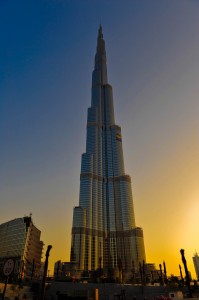By Korky Koroluk www.journalofcommerce.com
Its promoters were calling it the world’s first building in motion.

The “dynamic rotating tower” was to be 80 storeys tall, and each storey was to rotate independently around a central core. It was also to be the world’s first prefabricated skyscraper. And it was to be built in Dubai, on the shore of the Arabian Gulf.
It may still happen, but recent events in Dubai, throw the tower, and other imaginative projects, into question.
Readers of Daily Commercial News may have noticed the recent article about an elevator failure that caused Burj Khalifa in Dubai, to be closed just a month after its grand opening.
Fifteen people were trapped when their elevator got stuck near the 124th floor, stranding, as well, several dozen other people on the observation deck above.
Everyone made it safely back to ground level, but the incident was a blow to Dubai, a city-state that is one of the seven sheikdoms that make up the United Arab Emirates.
Dubai had been living for years on money borrowed from its oil-rich neighbours. In fact, it had received US$20 billion in bail-out money from Abu Dhabi, another of the emirates. But that still left something like US$60 billion in debt.
All of this is important because some of the most innovative building projects in the world have been pioneered in recent years in the countries of the Arabian Gulf.
The future of some projects still just on the drawing board is in serious doubt, and that’s too bad, because among them are jobs that explore concepts important to construction elsewhere.
For example, the rotating tower is to have a wind turbine between each floor — 79 turbines in all generating enough electricity to power the building and for other nearby buildings as well.
There would also be enough energy to run the rotating floors.
Each of those floors would rotate at a different rate, with the speediest making one complete turn every three hours and the slowest 24 hours. The result would be a building with a different shape every time you looked at it.
Residents would have constantly changing views, and, if you’re rich enough, I guess that might be a selling point. But there are other things that I think are more important.
Most of the construction would take place off-site, with only the foundations and central core being completed at the construction site.
Each factory-built module would be complete with pre-installed kitchen and bathroom fittings to minimize the amount of work needed at the site. Once each of the 40 prefab modules for each floor are finished, they’re to be transported to the site and plugged into the core.
As the world looks for ways to reduce its dependence on energy generated by burning oil and coal, ideas for in situ generation become more and more important.
Using factory-built modules can be an important way to control energy use during construction, and to control waste, as well.
I’ve not seen any cost estimate for the rotating tower, although it would be high, and Dubai is having to tighten its belt. Still, if this tower can be built, one of the values it would contribute would be what scientists call proof of concept.
Even if it isn’t built, two others are being planned — one in Moscow and one in New York City — and one of them might end up being a test-bed for all the new ideas (and new takes on old ideas) that would be incorporated.
Of course, if you’re one of the people who feels queasy watching the landscape pass by as you dine in one of Canada’s several rotating restaurants, you might not be interested in living in an apartment that won’t hold still. But wouldn’t it be fun to build one?












